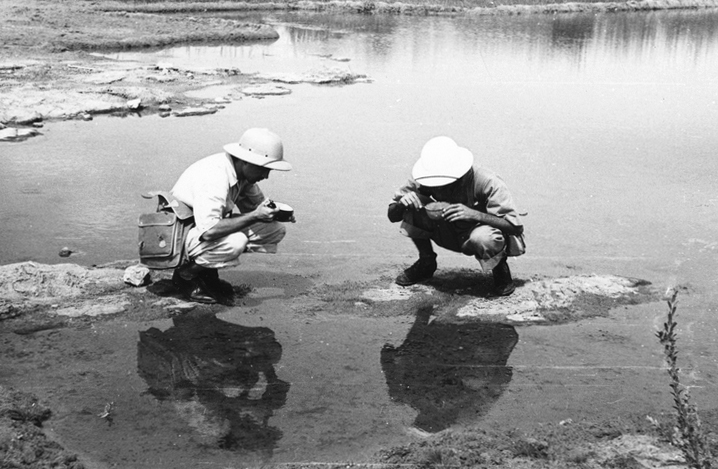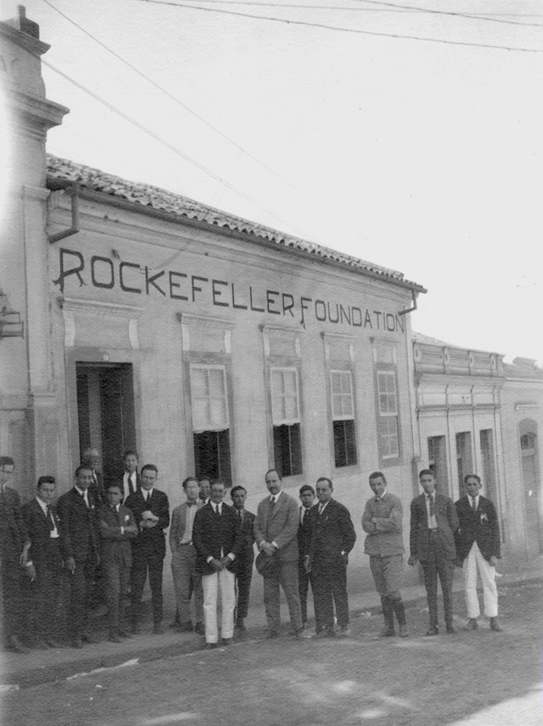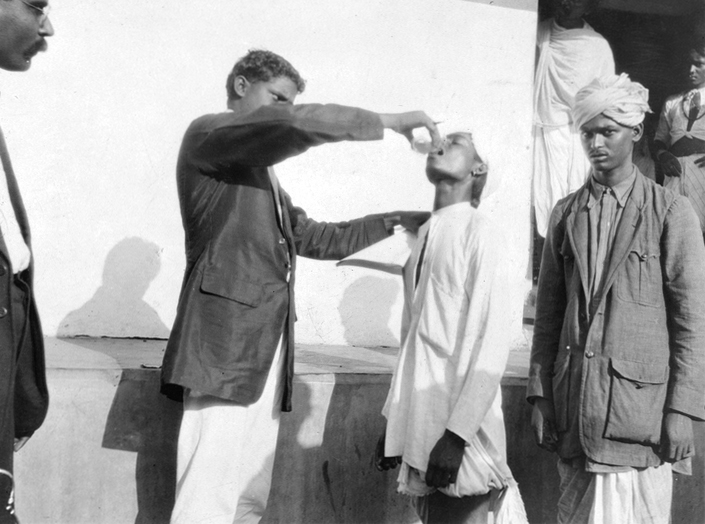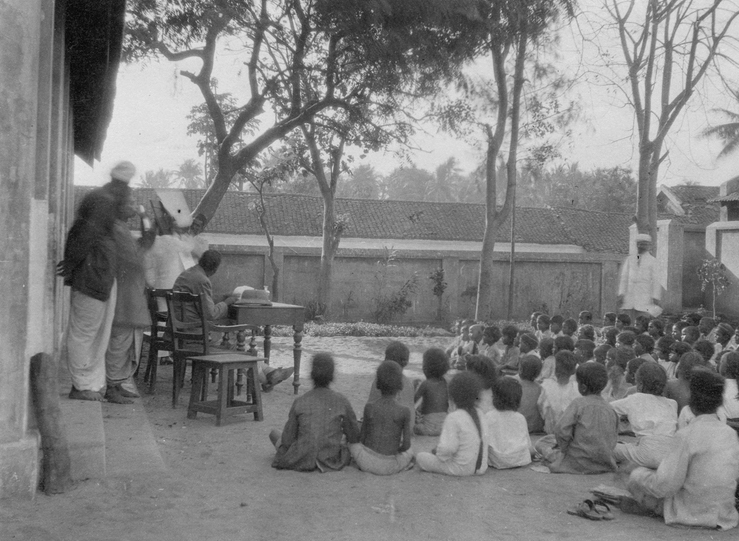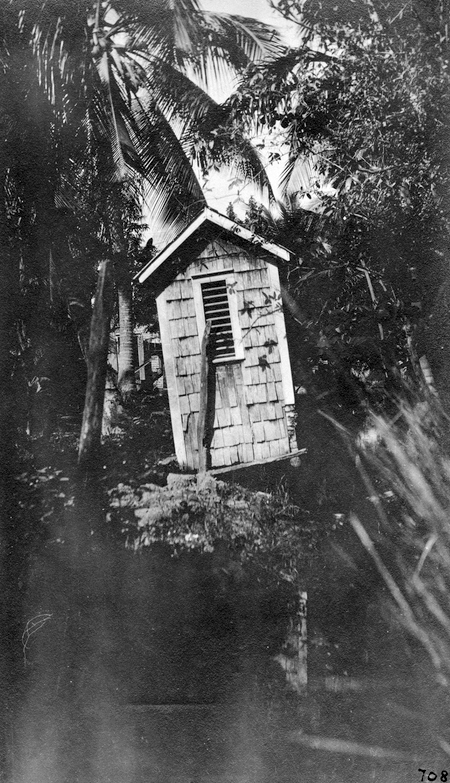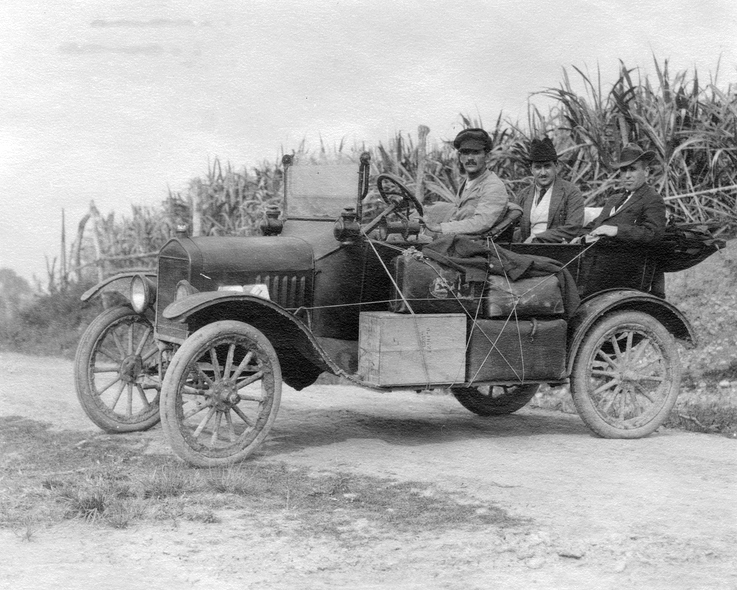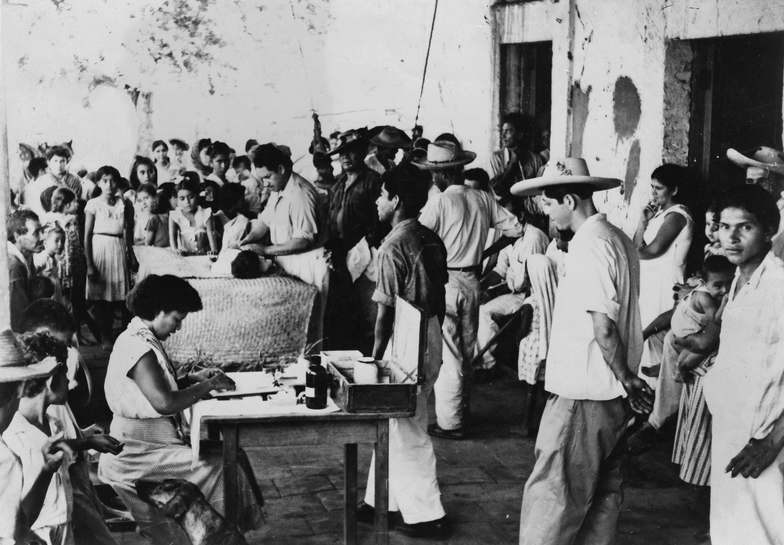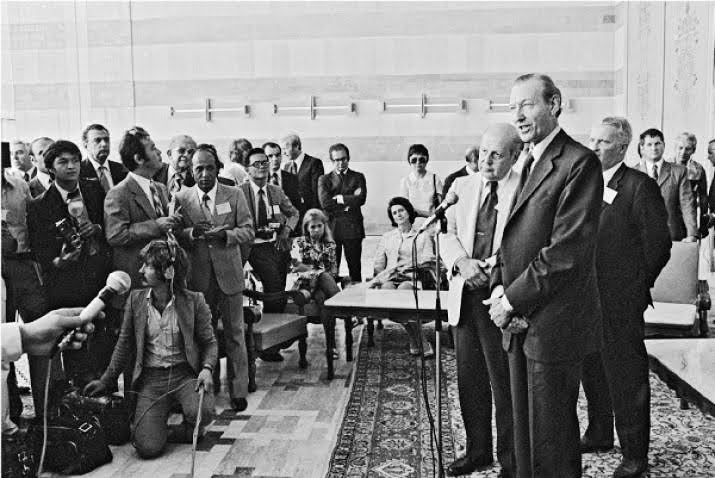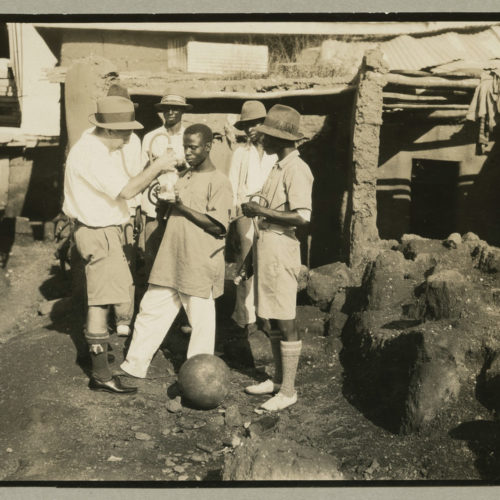The Start of Something Big
The International Health Commission was created on June 27, 1913, charged with the “ … promotion of public sanitation and the spread of knowledge of scientific medicine … ”The Rockefeller Foundation, Resolutions Establishing the International Health Commission, June 27, 1913, Rockefeller Archive Center, RG 3.1, Series 900, Box 18, Folder 129.
Throughout its history, the organization underwent a variety of mandate and name changes, becoming the International Health Board (IHB) in 1916 and the International Health Division (IHD) in 1927. Ultimately, the organization initiated programs in over 80 countries.
The IHD was the successor organization to the Rockefeller Sanitary Commission (RSC). Unlike the RSC, which had focused its activities in the southern United States, the IHD tackled public health issues on a global level. The IHD mirrored the successful model of the RSC. First, the agency collaborated with local governments to address specific diseases. Second, the agency sought to use specific diseases as catalysts to build a permanent network of public health agencies. As with other Rockefeller Foundation (RF) initiatives the IHD aimed to achieve long-term results.
Setting Principles
The first director of the IHD was Wickliffe Rose. As a former director of the RSC, Rose well understood the important intersections between health and education. Rose firmly believed that education was the most useful tool in combating major diseases and that public health education was required for physicians, nurses, health agencies and local populations.
Under Rose’s tenure (1913-1922), the basic principles of the IHD were established:
- Public health work is fundamentally a function of the government.
- IHD can be of use by helping government agencies organize and by providing expert advice, financial resources and facilities for the education of health professionals.
- IHD aid is temporary and must be withdrawn when governments can control their own public health operations.
- All IHD aid must be given with the aim of creating or strengthening government health agencies.Lewis Hackett, Manuscript, Chapter 1: Introduction, Rockefeller Archive Center, RG 3, Series 908, Box 5, Folder 28.
The IHD recognized early the value in adapting its practices to accommodate the customs and traditions of local populations. Successful public health education relied on speaking to people in terms that they understood and that made sense in their daily lives. As the 1916 Annual Report of the RF noted,
Experience derived from working in many countries, with their great diversity of races, languages, and racial prejudices, is gradually evolving working methods adapted to diverse conditions.
Rockefeller Foundation Annual Report, 1916The Rockefeller Foundation, Annual Report 1916 (New York: The Rockefeller Foundation, 1916) 54.
When setting its public health agenda, the IHD looked for diseases with a global health impact and a global economic impact (diseases that stunted a country’s economic growth by reducing the productive capacity of its citizens).The Rockefeller Foundation, Annual Report 1926 (New York: The Rockefeller Foundation, 1926) 83. The first overseas venture for the IHD was a cooperative project with British colonial authorities to bring a hookworm eradication program to British Guiana. The success of this campaign allowed the IHD to expand its international hookworm programs very quickly and to initiate campaigns against other diseases, most notably tuberculosis, yellow fever and malaria. The research and control of these four diseases comprised 90% of the disease budget of the IHD.John Farley, To Cast Out Disease: A History of the International Health Division of the Rockefeller Foundation (New York: Oxford University Press, 2004) 20.
Hookworm: Exporting a Campaign
In 1914, the International Health Division applied the lessons learned from hookworm eradication campaigns in the southern United States on a global scale. Ten years later, hookworm campaigns had been adopted in 52 countries across six continents and 29 islands.The Rockefeller Foundation, Annual Report 1924 (New York: The Rockefeller Foundation, 1924) 39.
Why Hookworm?
The IHD’s decision to undertake hookworm eradication as the first of its international projects was deliberate. Hookworm disease proved an ideal “wedge” that would allow for the creation or extension of public health organizations. Facts about hookworm disease were simple and easy to understand and could be clearly conveyed. IHD members saw hookworm as not only a disease but also as an opportunity for education. Illiterate populations could be educated through pictures, charts and health demonstrations that explained the dangers of the disease and the importance of sanitation.
The International Experience
The first hookworm campaigns outside of the United States began in British Guiana in 1914. Wickliffe Rose, director of the IHD, approached the British Colonial Office with his intentions in 1913 and quickly established a partnership between the two organizations. However, confusion over responsibilities prevailed. Disagreements between American and British staff were common, and the question of exactly which activities would be funded was a constant source of conflict. Following an established pattern, the Rockefeller Foundation (RF) had agreed to cover the costs of medical surveys, treatment and public education, while trusting that the local government would assume responsibility for funding the construction of privies and the establishment of a public health network. On the other hand, the colonial authorities of British Guiana saw the RF as an unlimited source of wealth that could and should assume all associated costs related to both treatment and preventative care.
As the numbers and locations of hookworm campaigns increased, so too did the problems that the RF encountered. However, the organization remained optimistic, writing in the 1920 Annual Report that:
Demonstrations in the control of this one disease, while bringing relief to hundreds of thousands of suffering people and increasing the economic efficiency of communities and countries, are having a more important effect in creating a popular interest in public health and in promoting the development of permanent agencies for the control of this and other preventable diseases.
Annual Report of the Rockefeller Foundation, 1920The Rockefeller Foundation, Annual Report 1920 (New York: The Rockefeller Foundation, 1920) 110.
Yet fueling interest in public health, and creating agencies to deal with it, was often more complicated than the report let on. For example, in the case of Madras Province in India, the numbers of infected persons overwhelmed staff and resources. The afflicted population was largely transient, and issues of poverty and caste stood in the way of privy construction.The Rockefeller Foundation, Annual Report, 1924 (New York: The Rockefeller Foundation, 1924) 116.
The local colonial government was also unwilling to fund sanitary initiatives. Intensive work began in Madras in 1922, but by 1928 the campaign had ended with mixed results.
While IHD initiatives increased public awareness of hookworm in India, the RF was not able to rid the region of the disease or to elicit local funding for initiatives in sanitation and public health. The experience caused a fundamental shift in IHD policy in favor of undertaking hookworm campaigns only in areas where latrines were already in place. This decision mirrored the programmatic decision to shift from the broader goals of sanitation and public health to medical research and treatment. This decision would echo in subsequent IHD-led initiatives.
By the end of the 1920s, almost all IHD hookworm eradication campaigns had ceased. Instead, the IHD directed its energy toward other serious health concerns, including the often fatal diseases of malaria and yellow fever.
Changing Course
Frederick Russell succeeded Rose as IHD Director from 1923 to 1935. Russell’s tenure marked an important transition for the organization to a greater research mandate. Both directors sought to eradicate preventable diseases on an international level. While Rose advocated the delivery of already acquired public health knowledge to greater numbers of people, Russell encouraged the discovery of new knowledge. As a 1928 memorandum on the future of the IHD explained:
… in order to preserve and to develop the inquiring attitude of mind in the working of the staff of the IHD, from the highest to the lowest, it is essential that investigation should be carried on within the organization itself and comprise an important part of its activities. The staff of the IHD is supposed to be composed of scientific men. Every effort must be made to keep them such … What is needed is a somewhat less wide dispersal of the activities of the Division, an increased emphasis to be laid on the importance of research both in the field and in the laboratory, and an attempt to cultivate the spirit of investigation in the members of the staff.
Memorandum Concerning Future Developments in the International Health Division of the Rockefeller FoundationMemorandum Concerning Future Developments in the International Health Division of the Rockefeller Foundation, 1928, Rockefeller Archive Center, RG 1, Series 100, Box 11, Folder 91.
IHD research during this era was dominated by the search for causes of diseases, paths of transmission and possible vaccines. The Rockefeller laboratories in New York City, established under Russell’s tenure, became a center for respected medical research and the site of the discovery of the yellow fever vaccine.
The War Encroaches
Russell was succeeded by Wilbur Sawyer, who from 1935 to 1944 maintained Russell’s research mandate but was also forced to deal with the complications brought on by World War II. In 1941 the IHD was forced to suspend operations in Europe, and the resources previously devoted to Europe were largely redirected to South America. Shortly before this the Rockefeller Foundation Health Commission was created in 1940 to address wartime health needs, including growing problems with refugees, food shortages, and epidemics.
According to an RF Review of the IHD, the commission was
… an effort to contribute to the war and postwar needs by salvaging existing health activities and personnel. Within the general framework of Foundation policies and objectives, the aim was to make a constructive contribution without becoming involved in the support of relief activities.
Rockefeller Foundation Review, 1949The Rockefeller Foundation Commission on Review of the International Health Division, Expenditures of the IHD, 1913-1949, Rockefeller Archive Center, RG 3, Series 908, Box 14, Folder 145.
The war had a tremendous impact on the IHD. Postwar concerns led to the growth of government funding of health initiatives and multilateral organizations devoted to public health. Among these new organizations was the World Health Organization (WHO), formed in 1948. The final director of the IHD, George Strode, shepherded the organization through these last years. In 1951 the IHD was subsumed into the RF’s Division of Medicine and Public Health. An increasing amount of emphasis was placed on medical education, including funding for professional education, medical faculties and individual fellowships.
…the aim was to make a constructive contribution without becoming involved in the support of relief activities.
Rockefeller Foundation Commission on Review of the International Health Division
Documenting the Work
During its history, the IHD counted a number of influential field staff and scientists among its ranks, including Lewis Hackett, its longest serving member. Hackett was recruited in 1914, and his impressive career in disease investigation and public health promotion spanned 35 years and involved work in 17 countries before his retirement.
Hackett faithfully documented his own experiences, producing an extensive photograph collection throughout his travels. During his retirement, Hackett began work on a definitive history of the IHD; however, the work was not completed before his death in 1962. The unfinished manuscript, available at the Rockefeller Archive Center (RAC), remains an invaluable tool for researchers.
Passing the Torch
By the time of its demise, the IHD had allocated over $94 million and had established a global reputation of excellence in public health and research. The organization fought the major diseases of its time, trained a cadre of health professionals and helped to establish public health agencies worldwide. Furthermore, the legacy of the IHD influenced the WHO in many concrete ways, especially the WHO’s Global Malaria Eradication Program, begun in 1955.
The model that the Rockefeller Foundation had pioneered soon fell out of fashion and was replaced with what would become in the 1970s community-based medicine. Famously, in September 1978, the WHO-sponsored International Conference on Primary Healthcare, held in Alma-Ata, Soviet Union, issued a declaration that:
The existing gross inequality in the health status of the people particularly between developed and developing countries as well as within countries is politically, socially and economically unacceptable and is, therefore, of common concern to all countries.
Alma-Ata Declaration, 1978
Alma-Ata went on to influence the practice of international public health. For its part, also in 1978, the Rockefeller Foundation returned to vigorous work in the field of public health when it launched the Great Neglected Diseases Program led by Kenneth Warren. The premise of that program was to tackle diseases, usually tropical diseases, that infected high numbers of people worldwide.
A Wide Contribution to Childhood Immunization
Along the same lines, in the 1980s, the Rockefeller Foundation sought to make a contribution to fight diseases known to affect large numbers of children throughout the world.
Today, it is estimated that each year 1.7 million children die from diseases that could be prevented through immunization. Campaigns to vaccinate all of the world’s children against fatal childhood diseases have been an ongoing initiative of the Rockefeller Foundation since 1985. Although much work remains, the combined efforts of the RF and other major international organizations have had a profound impact on the health of children world-wide.
The Rockefeller Foundation’s global efforts to provide childhood vaccines began in 1984, following an international meeting at the RF conference center in Bellagio, Italy, on the protection of the world’s children. International delegates from the fields of medicine, government and philanthropy met to discuss the concept of a global immunization program for children as one means of providing primary health care and reducing mortality among children in the developing world. The World Health Organization had already initiated the Expanded Program on Immunization (EPI) in 1980; however, in later years, the program had suffered from financial constraints. The Bellagio meeting resulted in hundreds of millions of dollars in funding allocated to the EPI. As a result immunization rates rose to 80% in some places, saving millions of lives. However, by 1990 donor fatigue had set in, and the spectacular success of the mid-1980s could not be repeated. The problem of childhood immunization required new ideas.
The Children’s Vaccine Initiative
The Children’s Vaccine Initiative (CVI), begun in 1990, represented one such idea. The CVI was a collaborative effort between the United Nations Development Programme (UNDP), the United Nations Children’s Fund (UNICEF), the WHO, the World Bank, and the RF, working with private and public partners that included government agencies, scientists and vaccine manufacturers. CVI served as an early model of a private-public partnership.
The ultimate goal of CVI was the creation of a one-dose oral vaccine that could be made easily available to children in the developing world. The ideal vaccine would protect against major childhood diseases and be easily administered to infants. Vaccines to be deployed in the developing world also had to be easily transportable and be able to maintain effectiveness without the benefit of refrigeration.Children’s Vaccine Initiative, Rockefeller Archive Center (RAC), Unprocessed Material, Box R2999, File H9232.
The CVI adopted a gradual strategy to develop this one-dose vaccine, with each goal resting on the one before it. These intermediate goals included:
- Improving existing vaccines
- Developing new vaccines
- Combining vaccines
- Enhancing vaccine production and quality control, and ensuring vaccine availability world-wideChildren’s Vaccine Initiative, Rockefeller Archive Center (RAC), Unprocessed Material, Box R2999, File H9232.
As a major sponsor of the CVI, the RF made a significant financial contribution toward its goal. In 1994 and in 1995, the RF allocated $1.3 million and $1.2 million, respectively, in order “[t]o support vaccine research programs and other activities related to the development and distribution of developing country children’s vaccines.”Children’s Vaccine Initiative Grants RF 93059 and RF 94051, RAC, Unprocessed, Box R3729, File 96019. Yet, in spite of such contributions, CVI still confronted financial shortages.
A New Player: The Bill and Melinda Gates Foundation
The Bill and Melinda Gates Foundation was formed in 1994, and one of its earliest goals centered on global immunization efforts. Publicity surrounding the new foundation and its funding agenda renewed attention on the issue and brought new funding opportunities. A World Bank Summit held at Bellagio in 1999 included senior staff of the RF, the Gates Foundation, WHO, World Bank and UNICEF. Participants concluded that a new organization, more closely linked to its funders, needed to replace the CVI. From this idea emerged the Global Alliance for Vaccines and Immunization (GAVI) in 2000.Gustav J.V. Nossal, “The Global Alliance for Vaccines and Immunization – A Millennial Challenge,” Nature: Immunology 1 (2000).
The Global Alliance for Vaccines and Immunization (GAVI)
GAVI defined its mission “to save children’s lives and protect people’s health by increasing access to immunization in the world’s poorest countries.” To accomplish these goals GAVI created a four-part strategy that includes:
- Accelerating the use of underused and new vaccines
- Strengthening health systems that deliver vaccines
- Increasing funding for vaccination and making such programs sustainable
- Shaping vaccine markets, so that vaccines remain affordable and appropriate for the world’s neediest
Following an RF model begun early in the 20th century with the hookworm campaigns, GAVI required the full cooperation of governments that chose to participate in the program. Commitment included creating committees that could coordinate the work of NGOs as well as government and United Nations agencies and local vaccine manufacturers. This level of participation ensured long-term commitment and created a vested interest by nations included in the program.
The involvement of local agencies and manufacturers also avoided the appearance of paternalistic relationships between international donors and local organizations. Sustainability was the primary goal of this model, which was intended to create permanent health agencies rather than build a reliance on external donors. Furthermore, GAVI aimed to be country-specific in approach, dealing with challenges particular to each nation, whether the challenges were institutional or relating to a disease specific to an area.Gustav J.V. Nossal, “The Global Alliance for Vaccines and Immunization – A Millennial Challenge,” Nature: Immunology 1 (2000).
The Rockefeller Foundation was for years a significant sponsor of GAVI, which exists to this day.
Fighting Disease at the End of the 20th Century
As the Rockefeller Foundation approached the twenty-first century, it continued to support projects intended to improve public health through several initiatives in disease surveillance and health systems transformation.
Research This Topic in the Archives
Explore this topic by viewing records, many of which are digitized, through our online archival discovery system.
- “International Health Division – Laboratories – History,” 1924-1950. Rockefeller Foundation records, Projects (Grants), Record Group 1, Subgroup 1.1, International, Series 100, General (No Program), Subseries 100.GEN, Rockefeller Archive Center.
- “(Yellow Fever),” 1928 January-1930 July. Rockefeller Foundation records, Projects (Grants), Record Group 1, Subgroup 1.1, Brazil, Series 305, Yellow Fever, Subseries 305.O, Rockefeller Archive Center.
- “Organization Reports – Org-2 – Org-6 DR 21,” 1913-1914. Rockefeller Foundation records, Administration, Program and Policy, Record Group 3, Subgroup 3.1, General Program and Policy, Series 900, Rockefeller Archive Center.
- “Program and Policy – Commission on Review – Reports – Pro CR-1 – Pro CR-4,” 1950. Rockefeller Foundation records, Administration, Program and Policy, Record Group 3, Subgroup 3.1, International Health Division, Series 908, Rockefeller Archive Center.
- “423 – British Guiana – Official,” 1915 & earlier. Rockefeller Foundation records, International Health Board/Division records, Record Group 5, Correspondence, Series 1, Project, Subseries 1_02, Rockefeller Archive Center.
- ““423 – British Guiana – Howard, H.H.,” 1914-1915. Rockefeller Foundation records, International Health Board/Division records, Record Group 5, Correspondence, Series 1, Project, Subseries 1_02, Rockefeller Archive Center.
- “464 – India – Pual, G. P.,” 1920. Rockefeller Foundation records, International Health Board/Division records, Record Group 5, Correspondence, Series 1, Project, Subseries 1_02, Rockefeller Archive Center.
- “464 – India – Kendrick, J. F.,” 1926. Rockefeller Foundation records, International Health Board/Division records, Record Group 5, Correspondence, Series 1, Project, Subseries 1_02, Rockefeller Archive Center.
- “464 – India – Kendrick, J. F.,” 1927. Rockefeller Foundation records, International Health Board/Division records, Record Group 5, Correspondence, Series 1, Project, Subseries 1_02, Rockefeller Archive Center.
- “Protection of the World’s Children – Conference,” 1983-1985. Rockefeller Foundation records, Projects (Grants), Record Group 1, Subgroup 1.12, Bellagio Study and Conference Center, Series 120, Rockefeller Archive Center.
- “Yellow Fever,” circa 1905-1980. Rockefeller Foundation records, Photographs, Brazil, Series 305, Yellow Fever, Subseries 305.O, Rockefeller Archive Center.
- “Yellow Fever Service, Rio de Janeiro,” circa 1905-1980. Rockefeller Foundation records, Photographs, Brazil, Series 305, Yellow Fever, Subseries 305.O, Rockefeller Archive Center.
- “Sawyer – Public Health in Colombia,” circa 1905-1980. Rockefeller Foundation records, Photographs, Colombia, Series 311, Public Health Demonstrations, Subseries 311.J, Rockefeller Archive Center.
- “Program Activities,” circa 1905-1980. Rockefeller Foundation records, Photographs, Mexico, Series 323, Malaria, Subseries 323.I, Rockefeller Archive Center.
- “Hookworm,” circa 1905-1980. Rockefeller Foundation records, Photographs, Guyana (formerly British Guiana), Series 423, Hookworm, Subseries 423.H, Rockefeller Archive Center.
- “Staff and Offices,” 1914-1916. Rockefeller Foundation records, Photographs, Guyana (formerly British Guiana), Series 423, Hookworm, Subseries 423.H, Rockefeller Archive Center.
- 311, Public Health Demonstrations, Subseries 311.J, Rockefeller Archive Center.
- “Photos Used in Field Reports – Annual and Semi-annual,” 1937-1939. Rockefeller Foundation records, Photographs, India, Series 464, Malaria, Subseries 464.I, Rockefeller Archive Center.
- “Brazil,” 1914-1949. Lewis W. Hackett Photographs, Negatives, and Slides, Series 1071, Photographs, Subgroup 1, Loose Photographs, Subseries 1.1, Rockefeller Archive Center.
- “Brazil,” 1914-1949. Lewis W. Hackett Photographs, Negatives, and Slides, Series 1071, Photographs, Subgroup 1, Loose Photographs, Subseries 1.1, Rockefeller Archive Center.
- “Peru,” 1914-1949. Lewis W. Hackett Photographs, Negatives, and Slides, Series 1071, Photographs, Subgroup 1, Loose Photographs, Subseries 1.1, Rockefeller Archive Center.
The Rockefeller Archive Center originally published this content in 2013 as part of an online exhibit called 100 Years: The Rockefeller Foundation (later retitled The Rockefeller Foundation. A Digital History). It was migrated to its current home on RE:source in 2022.
